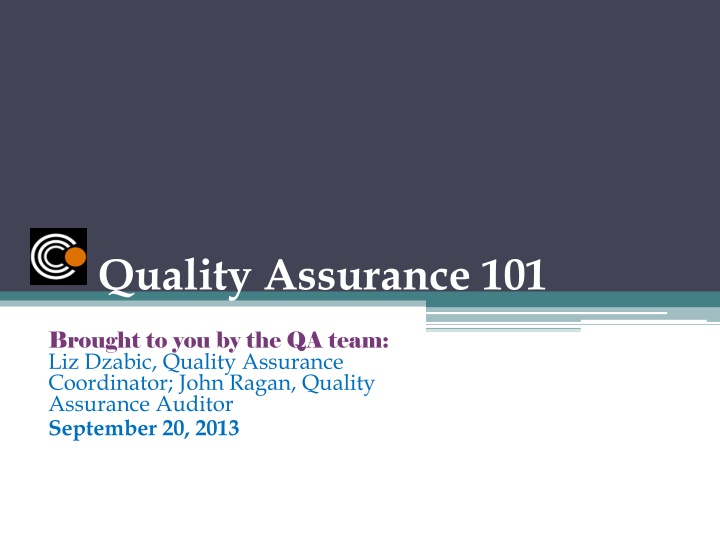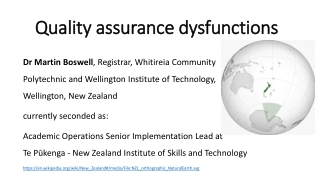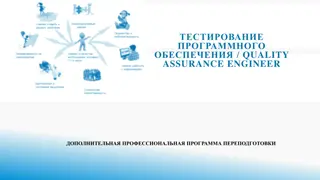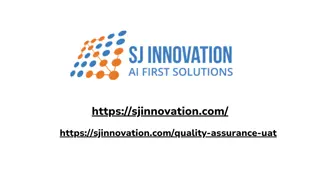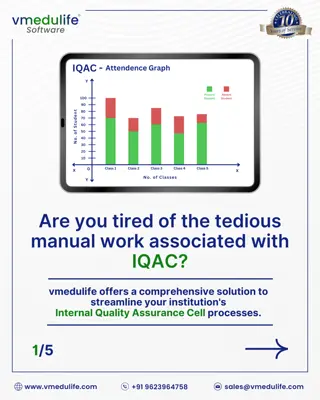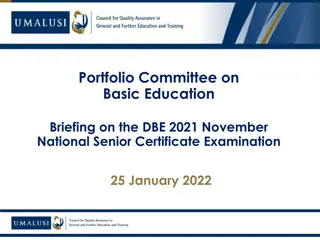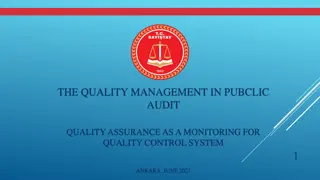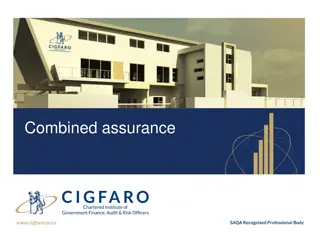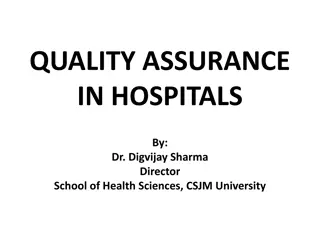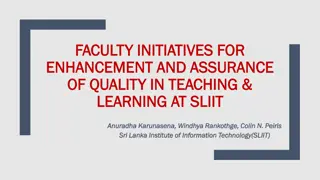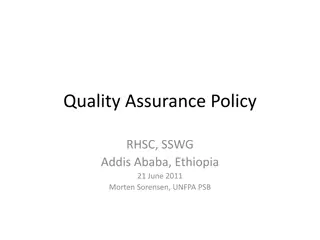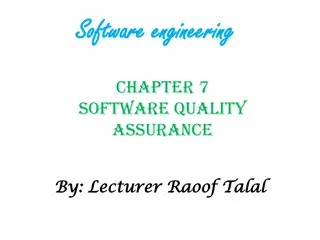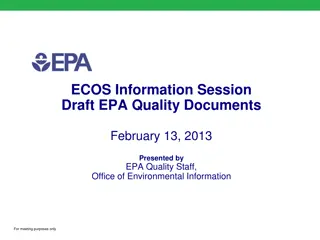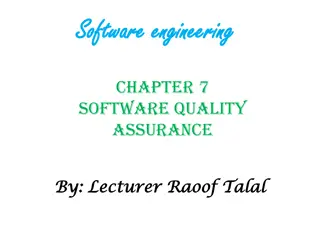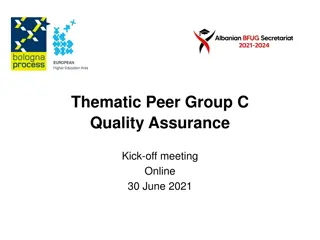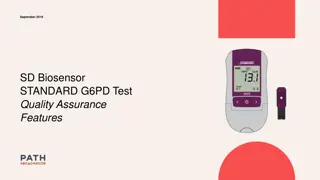Quality Assurance Insights for Online Course Development
Explore the essentials of quality assurance in online course design, emphasizing efficient navigation, assessment strategies, learner support, and technology utilization. Discover collaborative approaches, program goals, and pre-semester checks vital for ensuring excellence in online classrooms.
Download Presentation

Please find below an Image/Link to download the presentation.
The content on the website is provided AS IS for your information and personal use only. It may not be sold, licensed, or shared on other websites without obtaining consent from the author.If you encounter any issues during the download, it is possible that the publisher has removed the file from their server.
You are allowed to download the files provided on this website for personal or commercial use, subject to the condition that they are used lawfully. All files are the property of their respective owners.
The content on the website is provided AS IS for your information and personal use only. It may not be sold, licensed, or shared on other websites without obtaining consent from the author.
E N D
Presentation Transcript
Quality Assurance 101 Brought to you by the QA team: Liz Dzabic, Quality Assurance Coordinator; John Ragan, Quality Assurance Auditor September 20, 2013
We Will Cover Today . . . Part I. Quality Assurance at CCCOnline: Overview All hands on deck at CCCO Goals of our QA program Timeline of Quality Assurance reviews Evaluation path, contesting evaluation, support Part II. Activity: Quality Assurance evaluations
A Quality Online Course Will Be designed well with efficient navigation (course design / instructional design & delivery) Assess and evaluate learning clearly Provide learner support & resources Use technology appropriately (use of tools/LMS capabilities supports & enhances learning objectives) Foster student interaction/engagement Quality Matters: http://www.qmprogram.org/ Blackboard Exemplary Course Program Rubric: http://www.blackboard.com/getdoc/7deaf501-4674-41b9- b2f2-554441ba099b/2012-Blackboard-Exemplary-Course- Rubric.aspx Rubric for Online Instruction (ROI) from California State U-Chico: http://www.csuchico.edu/celt/roi/index.shtml
Our Collaborative Approach Be designed well with efficient navigation Instructional Design Team Foster student interaction / engagement Assess & evaluate learning clearly QA, Academic Team, Training CCCOnline Teams Academic Team A quality course will Academic Tech, Instructional Design, Academic Team Academic, Academic Tech, & Student Services Team Provide learner support & resources Use technology appropriately
CCCOs Quality Assurance Program Goals Encourage excellence in online classrooms Foster consistency across courses Provide documentation for Chairs & Associate Deans to advise instructors Areas for improvement Exemplary teaching
Before the Semester Starts First-day checks Program Chairs perform these checks Every course reviewed Corresponds to Course Readiness Checklist Communication between instructors and Chairs is essential
Start of the Semester Administrative reviews for new instructors Correspond to Threaded Discussion QA Rubric
During the Semester Full Quality Assurance evaluations For every instructor once/year New instructors: evaluated first two semesters Instructors with N mark(s) evaluated the following semester Chairs special requests evaluated Corresponds to Threaded Discussion QA Rubric
Evaluation Path (for both administrative & full QA reviews) Quality Assurance Evaluation 1 Program Chair Associate Dean 2 Instructor 3
Contesting an Evaluation Conversation between Quality Assurance staff and Program Chair and/or Dean When evaluation includes low marks (scores of N): Follow-up mentoring
Support for Instructors CCCOnline Instructor Handbook (Discussion) CCCOnline Training & Professional Development ( Managing Discussions workshop, webinars) Ongoing coaching and support from Associate Deans and/or Program Chairs
Quality Assurance Activity Samples originated from our classes Short excerpts from discussions to give you a rough idea of the evaluation process
Qualitative Criterion on Rubric Interaction Quality Best (B): Instructor regularly interacts with all learners in class, both on an individual and a group basis. Good (G): Instructor does acknowledge and validate posts, but in a less than substantial way, and/or may not consistently include all class participants and their concerns. Needs Improvement (N): Instructor regularly responds to only a select few individuals; may not answer all learner questions and/or responses only affirm that instructor reads student posts.
Qualitative Criterion on Rubric Acknowledgement Best / Good (B / G): Instructor posts regularly acknowledge learners' understanding of content. Needs Improvement (N): Little or no acknowledgement is made of learners' understanding of content.
Qualitative Criterion on Rubric Additional Posts Best / Good (B / G): Instructor posts regularly add additional information and direct or re- direct the discussion or appropriately close it. Needs Improvement (N): Instructor posts do not regularly further the discussion or appropriately close it.
Qualitative Criterion on Rubric Engagement/Re-Engagement Best (B): Instructor posts regularly re-engage individual learners as well as the entire class through the use of additional questions at the same or higher level. Good (G): Instructor posts regularly re-engage learners through additional questions at the same or higher level. Needs Improvement (N): Limited or no re- engagement occurs.
Lets Look at the Following Excerpts for . . . Interaction Quality Acknowledgement Additional Posts Engagement/Re-Engagement Classes: U.S. History & Fundamentals of Mathematics (MAT 030)
Subject: Re: Puritans and The Great Awakening Author: Cecily Student The Puritans were a group of people that were dissatisfied with and wanted to purify the Church of England and reform society, religion and morals. The Great Awakening was a period of religious "revivals" in places such as America, England, Germany and Scotland and has been said to be the most important event in the history of religion. Resources: http://www.nd.edu/~rbarger/www7/puritans.html; http://www.digitalhistory.uh.edu/database/article_display.cfm?HHID=687 A. (Instructor Response) Hi Cecily, What were the revivals like? *********************************************************************** Subject: Re: Puritans and The Great Awakening Author: Jack Student The Great Awakening made a lot of people realize that your own individual beliefs are a little more important than a set religion. It allowed people to override what the church was telling them to do and instead focus on what they thought their god would want them to do. B. (Instructor Response) Hi Jack, Who were some of the leaders of this movement and what are some examples of their messages? ***********************************************************************
Subject: Re: Puritans and The Great Awakening (the first) Author: Algernon Student Oops. I forgot to add about the Halfway Covenant. The Halfway Covenant was an idea created by Puritan ministers that was an attempt to increase membership in the church. Decline in conversions had been cause by less people testifying to "saving grace" experiences. The Halfway covenant did succeed in a greater amount of people converting, but it removed the purity that the Puritans had when the only method to obtain membership was a testimony of direct contact with God. The Halfway Covenant allowed people to convert to members of The Church, but restricted them from having the same rights to communion. Children of those converted under the Halfway Covenant, were automatically granted full membership, even if they lacked Baptism. C. (Instructor Response) Hi Algernon and class, What does this tell you about the view of religion and the youth? *********************************************************************** Subject: Re: Puritans and The Great Awakening Author: Gwen Student The Great Awakening was also one of the major causes of the Revolution. The colonists realized that they wouldn't be able to practice religious freedom while being ruled by the Church of England and the King. There were many other factors that lead to the Revolution, but religious freedom was one of the major factors that changed the history of the world and created the United States. D. (Instructor Response) Hi Gwen and class, The enlightenment and the Great Awakening were certainly contributing factors to the movement away from Colonial Life to a new nation. Class, what was the enlightenment period about and how would that affect people's beliefs? ***********************************************************************
Moving into the Other Class. . . What differences might you expect to see in a developmental-level Math discussion? Same QA criteria apply: Interaction Quality Acknowledgement Additional Posts Engagement/Re-Engagement
Subject: Unit G Discussion Author: Peyton Student A flight from Boston to Pittsburgh takes 2 hours and 35 minutes. How many minutes long is the flight? To slove this problem we need to first convert hours into minutes. 1 hour=60 minutes Therefore, 2 hours=120 minutes Now we just need to add. 120+35=155 minutes A flight from Boston to Pittsburgh is 155 mintues long. A. (Instructor Response) Peyton - Thanks for explaining the problem with every detail. This is one type of problem that will be used quite a bit in algebra. *********************************************************************** Subject: Unit G Discussion Author: Tim Student 3.4 tons of bananas are off-loaded from a ship that has just arrived from Costa Rica. The port taxes imported fruit at $0.015 per pound. What is the tax on the entire shipment? First thing that you have to figure out is how many pounds that you have. So you would multiply the 3.4 tons by 2000 pounds. Because there are 2000 pounds in 1 ton. 3.4 2000=6800/ Next you multiply the 6800 pounds of bananas by the $0.015 per pound tax. / 6800 $0.015=$102.00 / So the total port tax due on these bananas is $102.00. B. (Instructor Response) Tim -I love your logical approach to the problem. One great thing about working math problems...multiple ways to work them. Another approach using the information you provided: 3.4tons 2000lb1 ton $0.0151 lb Once we simplify the tons and lbs we are left with.... 2000 * 0.015 = $102 ***********************************************************************
Subject: Unit G Discussion Author: Drew Student Converting 38 ft/sec to m//sec are two steps to follow: 1) Find the equivalent measure that begins with the unit and ends with the unit you want. 2) Multipl by the unit fraction. C. (Instructor Response) Drew - when I do the math in your problem I am not getting the same answer you have. Please revise.... *********************************************************************** Subject: Unit G Discussion Author: Aaron Student The world's highest dam, the Rogun dam in Tajikistan, is 335 meters high. How many kilometers high is the dam? To convert meters to kilometers we need to know that 1 meter is equal to 0.001 kilometers. So, 335 meters would be 0.335 kilometers How I did this was by moving the decimal point to the left three spaces or multiply 335m X 0.001km=0.335km D. (Instructor Response) That is correct Aaron :) There is a saying to help remember the order: Kelly Hurriedly Drew Monkeys During Class Monday km hm dam m dm cm Since we are moving from m to km we go 3 to the left...moving the decimal point to the left three spaces. *********************************************************************** 38ftsec 305 ft1m=11.59m/sec In doing this there mm
Questions? Keep in touch with your Chair and Associate Dean Thank you for your participation!
